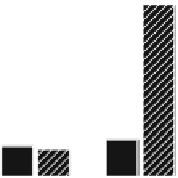Biology Reference
In-Depth Information
a
b
20
18.2
Glucose
Lactate
Pyruvate
Fatty Acids
Amino Acids
Ketons
140
Glucose
Palmitic acid
120
15
100
80
10
60
40
5
3.8
3.16
2.8
20
0
0
ATP/O
kJ/g
Postabsorptive
After Fat
Fig. 11.5 The role of fatty acid oxidation in metabolism. (a) (i) ATP synthesis to oxygen
consumption ratio in mitochondria for glucose and palmitate oxidation and (ii) the Gibbs free
energy of ATP hydrolysis from the actin-myosin reaction obtained from the oxidation of one gram
of glucose in comparison with the oxidation of one gram of palmitate. (b) Comparison of the
myocardial oxygen extraction ratio of carbohydrates (glucose, pyruvate, and lactate) and
non-carbohydrates (fatty acids, amino acids, ketones) in a post-absorptive state and after ingestion
of FAs. In both states FAs oxidation is the prevalent source of energy for the heart [adapted from
Bing et al. (
1954
) with permission]
Randle cycle outlined the restrictions imposed on muscle glucose metabolism by
FA oxidation (Randle et al.
1963
). Further mechanisms of regulation of the
glucose-FA cycle in working heart were described by Neely and Morgan (
1974
)
with new insights being revealed since then (Hue and Taegtmeyer
2009
;
Taegtmeyer
2010
; Taegtmeyer et al.
2005
). These mechanisms account for changes
in the kinetics of fuels supply, mass transfer, and transformation including glucose
transport and glycolysis, FA transport,
β
-FAO, and the Krebs cycle in response to
variations in respiration rates and NADH oxidation.
11.4 Phosphotransfer Pathways (Kinase Cycles)
11.4.1 Creatine Biosynthesis and Transmembrane Transport
Creatine biosynthesis occurs in a two-step reaction; first, in the kidney and in
pancreas, the amino acids arginine and glycine are combined to form guanidino
acetic acid (GAA) by the enzyme AGAT (arginine-glycine amino-transferase), and
second, in the liver, where GAA, taken up from blood serum via GABA-2 (gamma-
aminobutyric acid transporte) (Tachikawa et al.
2012
), is methylated to generate Cr
by GAMT (guanidine-acetic acid methyltransferase) using SAM (S-adenosine-
methionine) as a substrate (Wyss and Kaddurah-Daouk
2000
). Creatine synthesized
in the liver is released into the bloodstream by a still unknown mechanism. Since
creatine is not produced in significant amounts in, e.g., heart, brain, skeletal, and
smooth muscle, where it plays an important functional role, it has to be imported by
these tissues from blood serum, using a specific creatine transporter (CRT) (Beard














































Search WWH ::

Custom Search